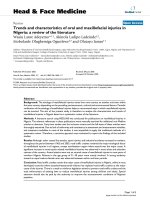Ebook A concise textbook of oral and maxillofacial surgery: Part 2
Bạn đang xem bản rút gọn của tài liệu. Xem và tải ngay bản đầy đủ của tài liệu tại đây (7.09 MB, 147 trang )
Inflammatory Disease
of Jaw Bone
OSTEOMYELITIS OF JAW
10
Etiology
Definition
It is a diffuse inflammation of the soft tissue and
bone involving the cancellous bone marrow and
the periosteal component. Osteomyelitis can also
be defined as an inflammation of the medullary
portion of the bone.
Osteomyelitis can be explained as an
inflammatory condition of bone that begins as
an infection of the medullary cavity and
haversian systems and extends to involve the
periosteum of the affected area.
i. Contigenous spread of odontogenic
infection
Classification
Suppurative
Osteomyelitis
Non-suppurative
Osteomyelitis
i. Acute suppurative
osteomyelitis
ii. Chronic suppurative
osteomyelitis
• Primary
• Secondary
iii. Infantile osteomyelitis
i. Chronic sclerosing
osteomyelitis
ii. Focal sclerosing osteomyelitis
iii. Diffuse sclerosing osteomyelitis
iv. Garre's sclerosing
osteomyelitis
v. Actinomycotic osteomyelitis
vi. Radiation osteromyelitis
and necrosis
ii. Trauma and injury leading to compound
fracture of teeth.
138
A Concise Textbook of Oral and Maxillofacial Surgery
iii.
2.
iv. Laceration and infections of the lymph node
leading to osteomyelitis via hematogenous
spread.
Osteomyelitis is more commonly seen in
patients with reduced host resistance, altered jaw
vascularity or those suffering from systemic
diseases.
Pathogenesis
Osteomyelitis is initiated from a contiguous focus
of infection or by hematogenous spread. Any
condition leading to the avascularity of the
medullary portion of the bone can lead to the
occurrence of osteomyelitis in that particular
bone.
Among the jaws, osteomyelitis is mostly seen
in the mandible as-• Maxilla is more porous and richly supplied
by blood vessels.
• Maxilla has thin cortical plates and paucity
of medullary tissues due to which any
maxillary infection remains confined within
the bone and the edema and pus dissipates
into the soft tissues and sinuses.
There are two sequelaes which have been
proposed for describing the pathogenesis of
osteomyelitis.
1.
The microorganisms causing osteomyelitis
are mainly of staphylococcus species, and
α-hemolytic streptococcus species. Besides these
peptostreptococci, fusobacterium and prevotella
species are also involved, thus mixed bacterial
cultures are seen.
Clinical Features
Clinically osteomyelitis is of four types:
i. Acute suppurative osteomyelitis
ii. Secondary chronic osteomyelitis - Begins
as acute and progresses to chronic
iii. Primary chronic osteomyelitis - Has no acute
phase and shows low grade infection
iv. Non-suppurative osteomyelitis.
i. Acute suppurative osteomyelitis is
characterized by:
a. Deep intense pain
b. High intermittent fever
c. Parathesia or anesthesia of lower lip
d. A clear identifiable cause, usually deep
caries in the involved tooth.
e. Increased temperature and malaise.
f. No radiographical findings
g. Edema and tenderness of overlying tissue.
If disease is not controlled by empirical
antibiotics within 10-14 days, it leads to
established suppurative osteomyelitis and
following findings are seen.
1. deep pain, malaise, fever (101-102°F),
anorexia.
Inflammatory Disease of Jaw Bone
2. Teeth begin to loosen and become sensitive
to percussion
3. Pus exudates around gingival sulcus and
through mucosa or cutaneous fistula.
4. Fetid oral odour
5. Firm cellulitis of cheek, abscess formation with
localized warmth, erythema, tenderness on
palpation and mental nerve parasthesia;
expansion of the bone due to increased
periosteal activity.
6. Regional lymphadenopathy.
ii. Secondary chronic osteomyelitis is
characterized by:
a. Minimal pain
b. Presence of fistula.
c. Induration of soft tissue
d. A thickened or 'wooden' character to the
affected area with pain and tenderness
on palpation.
iii. Primary chronic osteomyelitis is characterized by:
a. Insidious onset with slight pain.
b. Slow increase in jaw size
c. Gradual development of sequestra, often
without fistula.
Investigations
In acute stage osteomyelitis cannot be diagnosed
using radiograph as there is less of mineralized
bone destruction occurred.
In chronic stage, the following characteristic
features are seen in a radiograph:
a. Moth-eaten appearance of the bone involved
because of enlargement of medullary and
widening of Volkmann canal, secondary to
destruction by lysis of bone and its
replacement with granulation tissues.
b. Sequestra formation due to bone destruction
and islands of involcrum or new bone seen.
c. Granular dense bone formed due to
subperiosteal deposition of new bone and
this central sequestra formed helps to
distinguish osteomyelitis from fibrous
dysplasia.
139
Scintigraphy or bone imaging or radionuclide
scanning is a new diagnostic tool used to
determine the presence of reactive bone. 99mTclabelled phosphate compounds are given I.V to
distribute to the entire skeleton and concentrate
in areas of increased blood supply and reactive
bone. Rectilinear scanner or scintiliation camera
is used to image technetium. The image obtained
is used to reveal the distribution of radionuclide
in areas of increased bone activity. This technique
distinguishes reactive bone from the normal
bone but is unable to distinguish between the
reactive bone associated with osteomyelitis and
other conditions like fibrous dysplasia. However,
scintigraphy can confirm a diagnosis of very early
osteomyelitis before any radiographic bone
changes have occurred.
Treatment
Principles of Treatment of Osteomyelitis
1. Evaluation and correction of host defense
deficiencies
2. Gram staining, culture and sensitivity
3. Imaging to rule out bone tumor.
4. Administration of stained - guided empirical
antibiotics.
5. Removal of loose teeth and sequestra to
decrease the number of bacteria.
6. Administration of culture guided antibiotics;
repeated cultures.
7. Possible placement of irrigation drains/
polymethyl methacrylate - antibiotic beads.
8. Sequestrectomy, debridement, decortication,
resection, reconstruction (surgical management)
Antibiotic Therapy for Osteomyelitis
Appropriate use of antibiotics depends on the
stage of disease, host defense and ability to
obtain materials for lab diagnosis.
Antibiotics of importance in the treatment of
osteomyelitis are Penicillin, Penicillinase resistant
140
A Concise Textbook of Oral and Maxillofacial Surgery
Penicillin, combination of both penicillin,
clindamycin, cephalosporin and erythromycin.
Recommended antibiotics for osteromyelitis
treatment are:
Early Empirical therapy Aqueous penicillin,
2 million units, I.V 4th hourly until symptoms
have subsided for 48-72 hours, switch to
penicillin V, 500 mg P.O, 4th hourly for 2-4 week.
Initial therapy after staining If smear suggests
of staphylococcus infection - Oxacillin 1 gm, I.V
4th hourly until symptoms have subsided for
48-72 hours, then switch to Dicloxacillin 500
mg, P.O, 6th hourly for 2-4 weeks.
If smear suggests of anaerobic infectionAqueous penicillin 2 million units I.V 4th hourly
until symptoms have subsided for 48-72 hours
then switch to penicillin V, 500 mg, P.O 4th
hourly for 2-4 weeks.
For penicillin allergic patients Clindamycin,
600 mg, I.V 6th hourly then switch to
clindamycin, 300-450 mg, P.O, 6th hourly OR
Cefazolin 500 mg I.V or I.M 8th hourly then
switch to cephalexin 500 mg P.O 6th hourly.
Surgical Management of Osteomyelitis
Initially in acute stage only removal of very loose
teeth and bony fragments as well as incision and
drainage of fluctuant area is indicated.
In chronic stage further surgical intervention
is indicated, like
i. Sequestrectomy with or without saucerization.
ii. Decortication
iii. Resection followed by reconstruction. Along
with this Hyperbaric oxygen therapy (HBO)
is used as an adjuvant to hasten healing.
Incision and Drainage
Intraoral or extraoral incision is carried out to
relieve the patient of the pain and pressure
caused by the accumulation of pus and also
prevent the further spread of infection. Pus
drainage from the bone can be accomplished
by:
a. Opening up the pulp chamber
b. Making fenestration through cortical plate
over apical area.
c. Making an incision and opening a window
over the alveolar crest, especially in case of
edentulous posterior maxilla.
d. Making a small incision over the point of
greatest tenderness or below mandible in case
of osteomyelitis of ramus or angle of
mandible.
Sequestrectomy With or
Without Saucerization
Sequestrectomy is the removal of the sequestra
to prevent the spread of infection and minimize
tooth mobility (Fig. 10.1).
Sequestra are cortical or cortico - cancellous
bone generally formed 2 weeks after the onset
of infection and are avascular bony fragments
which are poorly penetrable by antibiotics and
are highly susceptible to pathologic fracture. To
prevent high instances of fracture, spread of
infection and hasten healing, sequestrum is
surgically removed.
Saucerization is the excision of the margins
of necrotic bone overlying an osteomyelitis which
will allow visualization of sequestra before
removal (Fig. 10.2). This procedure is performed
immediately after the acute stage and is rarely
done in maxilla as oro-antral fistula can result.
Procedure
• Reflection of the buccal flap of the affected
region to expose bone.
• Remove the loose teeth.
• Buccal plate is reduced by rongeurs to
produce saucer like defect.
• Granulation tissue and debris are removed
and the area is thoroughly irrigated.
Inflammatory Disease of Jaw Bone
• The buccal flap is trimmed and medical pack
(iodoform gauge and antibiotic pack) is put
to promote healing.
• Pack is maintained by sutures until bone
margin is healed.
141
• Reflection of the mucoperiosteum.
• Removal of the involved tooth.
• Removal of lateral cortical plate and the
inferior border, 1-2 cm beyond the affected
area to provide access to the medullary cavity
(Fig. 10.3).
• Thorough debridement of the tissues and flap
closure.
• Irrigation tube may be placed through
separate cutaneous stab incisions and closed
irrigation suction may be employed.
Fig. 10.1: Sequestrectomy
Fig. 10.3: Decortication
Resection Followed By Reconstruction
Fig. 10.2: Saucerization
Decortication
Decortication is the removal of chronically
infected cortex of bone. It is done during the
subacute or chronic stage of infection thus
removing the avascular infected cortical bone.
Decortication is done in conditions where the
initial conservative treatment has failed and also
as an initial treatment of primary and secondary
chronic osteomyelitis.
Procedure
• Reflection of the buccal flap of the affected
region.
This is an aggressive procedure indicated during
the following conditions:
• Pathological fracture
• Persistent infection after decortication
• Marked disease of both cortical plates.
Osteotomy is performed by an intraoral route
and immediate reconstruction is done using a
block of cancellous iliac crest bone or cancellous
marrow which is stabilized with titanium mesh,
thus helping in rehabilitation of the region.
Complications During
Surgical Management
•
•
•
•
Bleeding
Injury to inferior alveolar nerve
Pathological fracture
Discontinuity defect
142
A Concise Textbook of Oral and Maxillofacial Surgery
TYPES OF OSTEOMYELITIS
Garre's Osteomyelitis
(Chronic osteomyelitis with proliferative
periostitis, chronic non-suppurative sclerosing
osteomyelitis, periosteitis ossificians)
It is a focal gross thickening of the periosteum
with periapical reactive bone formation caused
due to mild irritation or infection.
Features
• Mainly seen in children and young adults.
• Mostly associated with carious mandibular 1st
molar but occasionally there may be no
dental etiology.
• Clinically, a localized, hard, non tender, bony
swelling of the lateral and inferior aspect of
the mandible is seen.
• Radiographically a characteristic 'ONION
SKIN' appearance is seen formed by the
laminated, smooth, focal, calcified bone
proliferation.
• Staphylococcus areus and Staphylococcus
epidermidis are the chief micro-organisms
associated.
• Treatment is best achieved by removing the
potential source of inflammation by
endodontic therapy or extraction of the
tooth involved. Antibiotics may not be
administered unless infection is present and
post treatment follow-up is essential.
Condensing Osteitis (Chronic focal
sclerosing osteomyelitis)
It is an unusual reaction of bone to infection
occurring in instances of extremely high tissue
resistance or in cases of low grade infections
Features
• Usually seen in patients below 20 years of
age.
• Mostly associated with infected pulp of
mandibular molars or premolars.
• Clinically the lesion is generally asymptomatic
with no or mild signs of pain.
• Radiographically, a circumscribed radiopaque
mass of sclerotic bone with distinct or
indistinct margins is seen associated with the
affected tooth roots.
• Histologically, a dense mass o bony
trabaculae with little interstitial marrow, soft
tissues and lymphocytes is seen.
• Treatment is best achieved by endodontic
therapy or extraction of the infected tooth.
• A similar condition is seen which is diffused
or multiple in form and is known as chronic
diffused sclerosing osteomyelitis. This
condition is treated by surgical sequestrectomy and debridement, decortication or
resection with reconstruction and adjuvant
antibiotic therapy.
Infantile Osteomyelitis
This is an uncommon condition associated with
infants but deserves a special care due to the
potential facial deformities resulting from delayed
or inappropriate treatment.
Features
• Infantile osteomyelitis is caused due to
hematogenous spread of infection from
mother, perinatal trauma of oral mucosa,
infections of maxillary sinus or contaminated
human or artificial nipples.
• Mostly seen in infants a few weeks after birth
and mainly maxilla is affected.
• Clinically, a facial cellulitis is present about
the orbit. Patient also shows fever, malaise,
irritability, dehydration, anorexia, convulsion,
palpebral edema, conjunctivitis, sinusitis and
vomiting.
• Treatment should be prompt and aggressive
to prevent optic damage, neurologic
Inflammatory Disease of Jaw Bone
complications, and loss of tooth buds and
bone. Antibiotic therapy with incision and
drainage generally surfise as the management.
Occasionally sequestrectomy may be
necessary.
143
purulent material with debridement of
surrounding tissues. Currently iodides and
radiotherapy are also used effectively.
OSTEORADIONECROSIS
Actinomycotic Osteomyelitis
Definition
It is a chronic infection manifesting both
granulomatous and suppurative features that
usually involve soft tissue and occasionally bone
of the cervicofacial, abdominal and thoracic
region.
It is a chronic, nonhealing wound caused by
hypoxia, hypocellularity and hypovascularity of
irradiated tissues.
Features
Clinically actinomycosis is of four types:
• Cervicofacial (most common)
• Abdominal
• Thoracic
• Cutaneous.
– Actinomycosis is caused due to an
infection of a gram positive filamentous
bacteria- Actinomycosis Israelli,
Actinomycosis viscosus, Actinomycosis
odontolyticus in patients with trauma,
dental caries or other hypersensitive
reactions.
– Clinically, a firm, soft tissue mass which
is oily, purplish or dark red is seen on the
skin. Small fluctuant areas which may
show spontaneous drainage of serous
fluid containing granular material may
occur.
– Regional lymphadenopathy is common.
– Radiographically, a radiolucensy is seen
associated with delayed healing of
extracted site.
– Histologically the yellow granules shows
closely packed branching filamentous
colonies.
– Treatment is best achieved by a combination of antibiotic therapy and surgery
involving incision and drainage of the
Pathogenesis
It is a radiation induced, nonhealing and hypoxic
wound rather than true osteomyelitis of
irradiated bone.
Radiation more than 5000 rad to jaws
↓
Death of bone cells
↓
Obliterative arteritis (arteritis with
hyalinization, fibrosis and
thrombosis of vessels)
↓
Aseptic necrosis of bone directly in beam of
radiation and having compromised
vascularity of adjacent bone and soft tissue.
• Mandible is more commonly affected than
maxilla as-– most old tumors are perimandibular
– dense cortical plates are absent in maxilla.
– Extensive vascular network is present in
maxilla.
Clinical Features
• Severe deep pain continuing till weeks or
months
• Presence of soft tissues abscess or draining
sinus and fistula
• Exposed bone with abraded and ulcerated
soft tissue (Fig. 10.4)
144
A Concise Textbook of Oral and Maxillofacial Surgery
• Facial swelling is present when infection
develops
• Trismus
• Fetid odour
• Pyrexia
• Pathological fracture.
• Radiographically, there is hardly any changes
seen as sequestra and involucra formation
is not seen or seen late in an irradiated bone
because of severely compromised blood
supply.
Fig. 10.4: Clinical view of osteoradionecrosis involving
the mandible (For color version see plate 3)
Management
Prevention of Osteoradionecrosis
1. Use of megavoltage commonly obtained
from cobalt teletherapy units, instead of the
use of orthovoltage in radiotherapy units.
2. Dose fractionation
3. Collimation to shield normal tissues
4. Maintaining pre-irradiation dental health
a. extraction of teeth 2-3 weeks before
radiation therapy done with alveoloplasty.
b. Restoration of dental caries and
periodontal health
c. Fluoride application
5. Maintaining post-irradiation dental health
a. extraction is contraindicated for 6-9
months
b. Dentures should not be worn for 1 year
c. Salivary substitutes are advised because
of xerotomia.
d. Endodontic treatment is indicated for
post irradiated pulpitis and not extraction.
If extraction is at all necessary then
should be done under proper care and
for 1-2 teeth only.
Treatment steps to be followed:
i. Administration of antibiotics (penicillin and
metrinidazole), analgesics and supportive
therapy with fluid, high protein and vitamin
diet.
ii. Irrigation of exposed bone and soft tissue
margin.
iii. Mechanical debridement and smoothening
of bone using bone files and burs, and
medicated dressing with zinc peroxide and
neomycin.
(irrigation and medicated dressing is repeated weekly until sequestra has occurred
or bone is penetrated by granulation
tissues).
iv. Series of holes are drilled perpendicular to
lingual cortical plate to the depth at which
bleeding bone is encountered. This method
was used earlier to encourage revascularization of the bone (ultrasound therapy)
v. Hyperbaric oxygen therapy with or without
bone resection.
Generally patients are treated for
osteomyelitis as outpatients but hospitalization
may be required for patients who shows toxic
symptoms and are dehydrated to permit
supervised administration of antibiotics and
fluids.
Inflammatory Disease of Jaw Bone
145
• Proliferation of granulation tissues
• Enhances arterial and venous oxygen
tension.
• Enhances sequestra formation and replacement of devitalised bone.
Fig. 10.5: Mechanism of HBO therapy
(For color version see plate 3)
Indications
•
•
•
•
Osteoradionecrosis
Refractory chronic suppurative osteomyelitis
Refractory chronic sclerosing osteomyelitis
Diffused sclerosing osteomyelitis
Contraindications
• Optic neuritis
• Immunosuppressive diseases.
HYPERBARIC OXYGEN THERAPY
(A PROCEDURE USED AS AN
ADJUVANT TO SURGERY)
It is a process of breathing 100 percent oxygen
at 2.4 atmospheric pressure for 90 mins/dive,
5 days/week. Totalling 30 sessions (Marx
protocol)
Mechanisms
• Bacteriostatic affect on microbes
• Induces neo-angiogensis
• Fibroblast proliferation under increased
oxygen tension
Fig. 10.6: Hyperbaric oxygen therapy unit
(For color version see plate 3)
146
A Concise Textbook of Oral and Maxillofacial Surgery
• Helps in fistula closure.
• Clinical and radiological healing
• Enhances bone graft osteogenesis.
FURTHER READING
Fig. 10.7: Patient under treatment in small unit
(For color version see plate 3)
Advantages
• Decreases pain
• Decreases trismus and increases patient
comfort.
1. Archer WH — Oral and maxillofacial surgery, 5th
ed, vol. 1.
2. Gustav O Kruger — Textbook of oral and
maxillofacial surgery, 16th ed.
3. Peterson, Ellis, Hupp, Tucker — Contemporary
oral and maxillofacial surgery, 4th ed, 2006.
4. Shafer-Hine-Levy — Shafer’s textbook of oral
pathology, 5th ed, 2006.
5. Topazian RG, Goldberg MG — Oral and
maxillofacial infection, 3rd ed, 1994.
6. White and pharaoh — Oral radiology, principles
and interpretation, 5th ed, 2006.
Surgical Procedures in
Prosthodontics–
Preprosthetic Surgery
Preprosthetic surgery are the surgical procedures
carried out to reform or redesign denture bearing
areas to create an oral environment to support
a functional prosthetic appliance.
Aims of Preprosthetic Surgery
1. Provide adequate bony tissues for prosthesis
support (Ridge height and width)
2. Provide adequate soft tissue support
3. Eliminate pre-prosthetic bony deformities
(Tori, Exostosis)
4. Correction of maxillary and mandibular ridge
relation
5. Relocate abnormal frenum and muscle
attachment
6. Relocate mental nerve
7. Establishing correct vestibular depth.
Classification of Preprosthetic Surgery
I. Ridge Correction Procedures
1. Hard tissue correction:
i. Alveoloplasty
a. simple alveoloplasty
b. single tooth alveoloplasty
c. radical alveoloplasty
d. interadicular alveoloplasty or
interseptal alveoloplasty
ii. Excision of tori
a. maxillary tori excision
b. mandibular tori excision.
11
iii. Reduction of maxillary tuberosity
iv. Reduction of genial tubercle.
v. Reduction of mylohyoid ridge.
2. Soft tissue correction:i. Frenectomy
a. Labial frenectomy
b. lingual frenectomy
c. Buccal frenectomy
ii. Removal of crestal soft tissue
iii. Removal of epulis fissuretum or fibrous
hyperplasia or denture fibrosis.
II. Ridge Extension Procedures:
(Vestibuloplasty or sulcoplasty
or sulcus deepening procedures)
1. Maxillary procedures:
i. Secondary epithelization technique
ii. Sub mucosal technique
iii. Grafting technique
2. Mandible procedures:
i. Buccal or labial approach
ii. Lingual approach
iii. Labial and lingual approach (floor of the
mouth lowering procedure)
III. Ridge Reconstruction or Augmentation
Procedures
1. Ridge reconstruction with non-resorbable
hydroxyapetite (onlay grafts)
148
A Concise Textbook of Oral and Maxillofacial Surgery
2. Ridge augmentation with iliac crest bone or
rib bone graft.
3. Ridge augmentation using osteotomy
technique:i. Interpositional bone graft
ii. Sinus lift procedure
iii. Augmentation with orthognathic surgery
iv. Visor osteotomy procedure
v. Sandwich osteotomy procedure
4. Implants for ridge reconstruction
i. Endosteal implants
ii. Subperiosteal implants
iii. Transosteal implants
CHARACTERISTIC OF
AN IDEAL RIDGE FOR
BEST DENTURE SUPPORT
They are:
1. No evidence of intraoral or extraoral
pathologic conditions.
2. Proper interarch jaw relationship in the
anteroposterior, transverse and vertical
dimensions.
3. Alveolar process that are as large as possible
and of the proper configuration. ( The ideal
shape of the alveolar process is a broad Ushaped ridge with the vertical components
as parallel as possible)
4. No bony or soft tissue protuberances or
undercuts.
5. Adequate palatal vault form.
6. Proper posterior tuberosity notching
7. Adequate attached keratinized mucosa in
the primary denture bearing area.
8. Adequate vestibular depth for prosthesis
extension
9. Added strength where mandibular fracture
may occur.
10. Protection of the neurovascular bundle.
11. Adequate bony support and attached soft
tissue covering to facilitate implant
placement when necessary.
I. RIDGE CORRECTION PROCEDURES
1. Hard Tissue Procedures
i. Alveoplasty or Alveolectomy: It is a process
of surgically removal of a portion of the
alveolar bone or shaping of alveolar ridge.
This procedure is mostly done after
multiple extraction or on uneven ridges
with a goal of conservation of maximum
amount of bone consistent with a good
ridge. The most conservative procedures is,
compression of the alveolar wall by finger
and thumb pressure.
ii. Excision of tori: A tori is a benign outgrowth
present only the mid-palatal suture of
maxilla (maxillary tori) or along the lingual
surface of mandible (mandibular tori).
These are removed to increase denture
retention and stability. Proper clinical and
Radiographic evaluation should be done
prior to surgery to rule out pneumatization
of tori (to prevent formation of oro-antral
fistula) in case of maxilla and nearness to
mandibular canal (to prevent damage to
nerve bundles) in case of mandible.
iii. Reduction of maxillary tuberosity: Maxillary
tuberosity is the bulbous extension of the
residual ridge in the upper second and
upper third molar region. In certain cases
this tuberosity is excessively enlarged (either
fibrous enlargement or bony enlargement)
and is better to be reduced to increase
intermaxillary space in the posterior region
and make the ridge regular. Proper
preoperative investigations should be done
to differentiate between fibrous or bony
enlargement and to rule out nearness to
maxillary sinus, thus prevent formation of
oro-antral fistula.
iv. Maxillary Tuberosity: This is a procedure
done to increase the depth of the hamular
notch and the distal aspect of maxilla in case
of flat maxillary ridge, thus preventing
anterior displacement of the denture.
Surgical Procedures in Prosthodontics—Preprosthetic Surgery
149
Types of Alveoplasty and Their Procedures
a. Simple
- here, buccal alveolar
plates and
interseptal
bone is removed.
b. Single tooth
- done following
removal of isolated
posterior tooth to
Reduce the
prominent buccal
cortical undercut.
Fig. 11.1
Fig. 11.2
c. Radical
d. Interradicular or
- here complete labial
Interseptal
plate is removed
- here the interradicular
in cases of extreme
bone is removed
prominent undercut,
in cases of
skeletal horizontal
prominant premaxilla
jaw discrepancy or
or skeletal class II
in preradiation therapy
disproportion
Fig. 11.3
Fig. 11.4
150
A Concise Textbook of Oral and Maxillofacial Surgery
Maxillary Torus Removal
Mandibular Torus Removal
Fig. 11.5
Fig. 11.6
Surgical Procedures in Prosthodontics—Preprosthetic Surgery
151
Maxillary Tuberosity Reduction
Bony enlargement
Fibrous enlargement
Incision extended along crest of alveolar ridge
Step 1
Elliptical incision around soft tissue
Step 1
Reflection of flap
Step 2
Reduction of bone and
reposition of flap
Step 3
Soft tissue excised
Step 2
Fig. 11.7
Soft tissue closure
Step 3
Fig. 11.8
Maxillary Tuberoplasty
Decreased depth of hamular notch
in posterior maxillary ridge
Step 1
Fracture line of plerygoid plate
Step 2
Pterygoid plate pushed posteriorly
Step 3
Flap suture at sulcus depth for
increase depth of hamular notch
Step 4
Fig. 11.9
152
A Concise Textbook of Oral and Maxillofacial Surgery
2. Soft Tissue Correction
i. Frenectomy: Frenum is a fibrous band of
tissue present on the maxilla and the
mandible which connects the lip or the
tongue to the jaw. Frenectomy is the surgical
removal of the excessively high frenum to
increases denture stability.
This procedure also increases the mobility of
the tongue (In case of high mandibular lingual
frenum, ankylosis of tongue occurs) and
improves the esthetics of the patient.
a. Labial Frenectomy
b. Lingual Frenectomy
a. Labial Frenectomy
After proper anesthesia we retract lip using a forcep
or traction suture and apply two hemostats on either
side of the frenum.
b. Lingual Frenectomy
After proper anesthesia we retract the tongue using
a forcep or traction suture and apply two hemostats
on either side of the frenum.
High labial frenum
Condition
High lingual frenum
Condition
2 cross diamond shaped incision placed
Step 1
2 cross diamond shaped incision placed and
submucosa undermined
Step 1
Suturing done
Step 2
Suturing done
Step 2
Fig. 11.10
Fig. 11.11
Surgical Procedures in Prosthodontics—Preprosthetic Surgery
153
Frenoplasty: This is the procedure of incising the frenum and suturing it back to a new position
to alter it structure.
Small elliptical incision on the mucosa
Step 1
Two incision placed
Step 2
Flaps reflected
Step 3
Flap rotated and sutured
Step 4
Fig. 11.12
iii. Removal of epulis fisseratum or fibrous
hyperplasia or denture fibrosis.
Epulis fisseratum or fibrous hyperplasia or
denture fibrosis is a generalized hyperplastic
enlargement of mucosa and fibrous tissue in the
alveolar ridge and vestibular area mostly due
to illfitting dentures. The conditions are mostly
treated by conservatively by relieving the area
and soft tissue liners. In certain severe cases
surgical treatment is also done.
(A) Large area of inflammatory
fibrous hyperplasia
(B) Flap sutured to the periosteum
at the depth of the vestibule
Fig. 11.13
154
A Concise Textbook of Oral and Maxillofacial Surgery
II. RIDGE EXTENSION PROCEDURE
(VESTIBULOPLASTY/SULCOPLASTY)
Vestibuloplasty is the uncovering of existing basal
bone of jaw surgically by repositioning the
overlying mucosa, muscle attachment and
muscle to a lower position in mandible or to a
superior position in maxilla.
1. Maxillary Procedures
i. Submucosal technique (Obwegeser)
ii. Grafting technique (combined pedicled
mucosal transposition flap and skin graft).
(i) Submucosal technique (Obwegeser)
(ii) Grafting technique
Excess submucosal tissue layer
Step 1
Incision placed
Step 1
Excision of soft tissue layer
Step 2
Flap reflected soft tissue excised
Step 2
Holding mucosa in place
Step 3
Skin graft placed along with splint
Step 3
Fig. 11.14
Fig. 11.15
Surgical Procedures in Prosthodontics—Preprosthetic Surgery
155
2. Mandibular Procedures
i. Buccal or labial approaches: This is the process of increasing the vestibular depth of the labial
side. The various procedures for this are:
a. Transpositional flap
Vestibuloplasty or
Lip Switch
(Kazanjian)
b. Modified Lip Switch
technique
(Edlan)
c. Submucosal technique
(Obwegeser's)
Step 1
Step 1
Step 1
Step 2
Step 2
Step 2
Fig. 11.16
The technique overcomes the
drawback of the lip switch technique of scar formation and long
term post-operative pain
Fig. 11.18
Fig. 11.17
156
A Concise Textbook of Oral and Maxillofacial Surgery
ii. Lingual approaches:
a. Lingual sulcus extension
(Trauner)
- Here mylohyoid muscle is repositioned.
b. Lingual ridge extension
(Caldwell)
- Here full thickness mucoperiosteum is Dissected.
Step 1
Step 1
Mylohyoid muscle positioned lower and
circumferential tie placed to hold muscle
Step 2
Mylohyoid ridge
excision is done
Step 2
Split skin graft
placed on bone
Step 3
Flap repositioned and mylohyoid
muscle held by circumferential tie
Step 3
Fig. 11.19
Fig. 11.20
Surgical Procedures in Prosthodontics—Preprosthetic Surgery
iii. Labial and lingual approach:
(Floor of mouth lowering procedure—Obwegeser)
Fig. 11.21
157
158
A Concise Textbook of Oral and Maxillofacial Surgery
III. RIDGE RECONSTRUCTION OR
AUGMENTATION PROCEDURES
These are procedures to increase the alveolar
ridge height in case where the ridge has fully
resorbed and other methods like vestibuloplasty
has failed.
Indications
1. Gross atrophy of alveolus and possibility of
further resorption.
2. Localized severe alveolar ridge defects
following surgery
3. Young patients with severe jaw atrophy
4. Atrophic maxilla causing prosthetic difficulty.
Graft Materials Used For Augmentation
1. Autografts/autogenous bone grafts:
i. Iliac crest bone (commonly used)
ii. Rib bone (Vth and VIIth rib)
2. Alloplastic bone graft material:
i. Hydroxyapetite (non- resorbable)
ii. Tricalcium phosphate (resorbable)
3. Allogenic bone graft
i. Freeze dried bone grafts
ii. Surface decalcified freeze dried bone grafts.
4. Xenograft materials
i. Bio-oss (bovine)
Procedures used for Reconstruction
or Augmentation
1. Ridge reconstruction using nonresorbable hydroxyapetite materials
(only grafts).
Techniques
After instituting proper local anesthesia a midline
incision (for maxilla) or bilateral vertical
mucoperiosted incision (for mandible) is done
on the ridge and a subperiosteal tunnel is made.
Hydroxyapetite graft material is inserted and
held in position by sutures followed by splint
(Fig. 11.22).
Fig. 11.22: Injection of hydroxyapetite
into subperiosteal tunnel
2.
3.
4.
5.
6.
Migration of hydroxyapetite particles.
Abrasion of mucosa and extrusion of particles
Infection
Abnormal colour over ridge.
Mental neuropathy.
2. Ridge augmentation with iliac crest
bone or rib bone graft
This technique is used to overcome the
complication of bone resorption and graft
extrusion of only bone graft procedure.
i. Superior border augmentation technique
Fig. 11.23: Superior border grafting of atrophic
mandible held by plates and screws
ii. Inferior border augmentation technique
Complications
1. Dehiscence with extrusion of hydroxyapetite
particles.
Fig. 11.24: Inferior border grafting done
and held by plates and screws
Surgical Procedures in Prosthodontics—Preprosthetic Surgery
3. Ridge augmentation using osteotomy
technique
i. Interpositional bone graft
159
ii. Sinus lift procedure.
Fig. 11.25: Graft and maxilla is stabilized
using rigid fixation plates
Fig. 11.26: Sinus lift
iii. Augmentation with orthognathic surgery:
(A)
(B)
Fig. 11.27: Mandibular sequential osteotomy to reposition molar tooth to function
iv. Visor osteotomy procedure: Here the lingual bone is raised and adapted to the remaining
mandible (Figs 11.28A and B).
(A) Vertical osteotomy procedure
(B)
Fig. 11.28
160
A Concise Textbook of Oral and Maxillofacial Surgery
v. Sandwich osteotomy procedure: This is a combination of horizontal osteotomy in the anterior
region and vertical osteotomy in the posterior region (Figs 11.29A to C).
(A)
(B)
(C)
Fig. 11.29: Sandwich osteotomy procedure
4. Implants for ridge reconstruction
A dental implant is a biologic or alloplastic biomaterial, surgically inserted into the soft tissue
or hard tissue of mouth for functional or cosmetic purposes.
Classification of Dental Implants
I. Depending on usuage:
1. Endosteal implants
i. Root form implants
a. Cylinder type
b. screw type.
ii. Plateform implants (blade)
2. Subperiosteal implants
3. Transperiosteal implants.
(A) Subperiosteal
(B) Transosseous
(C) Cylinder
Fig. 11.30: Types of dental implants
(D) Plate Form
Surgical Procedures in Prosthodontics—Preprosthetic Surgery
II. Depending on the material used:
1. Metal and alloy
i. Titanium
ii. Stainless steel
iii. Chromium - cobalt - molybdenum alloy
iv. Gold plated
2. Ceramic/porcelain
i. Bioactive glass
ii. Hydroxyapetite (HA)
iii. Aluminum oxide
3. Composite/resin
i. Polymethylmethocrylete
ii. Polyethylene
iii. Polypropylene
iv. Silicon
4. Carbon implants
Indications of Implants
1.
2.
3.
4.
5.
6.
7.
Edentulous patients
Ridge resorbed cases
Multiple missing teeth
Single missing tooth
Patient's desire
Severe parafunctional habits.
Poor oro-muscular coordination
Contraindications of Implants
1.
2.
3.
4.
5.
6.
7.
8.
9.
Acute illness
Terminal illness
Pregnancy
Uncontrolled metabolic disease
Turoricidal radiation to the implants site.
Unrealistic expectation
Improper motivation
Lack of operator experience.
Unable to restore prosthodontically.
161
3. The mean vertical bone loss is less than 0.02
mm annually after the first year of service.
4. No persistent pain, discomfort, or injection
is attributable to the implant.
5. The implant design does not preclude
placement of a crown or prosthesis with an
appearance, that is satisfactory to the patient
and the dentist.
Biological Consideration in Implant Tissue Interface
1. Soft tissue - implant interface reactions: The
collagen fibres at the junctional epitheliumimplant interface runs at right angle forming
a tight cuff of fibrous connective tissue which
supports the epithelium seal and forms an
effective barrier to peri-implant pocket
formation and bone loss.
2. Bone - implant interface reactions:
i. Fibro-osseous integration: It is the presence
of healthy dense collagenous tissue between
the bone and implant. In this conditions the
fibres run irregularly parallel to the implant
body and thus this interface shows a very
low success rate.
ii. Osteointegration: It is a direct structural and
functional contact between living bone and
a load carrying implant. This condition is
similar to ankylosis and provides a high
success rate. The factors needed for this are:
- biocompatible material choice
- Implant precisely adapted to prepared
bone site.
- Atraumatic surgery to minimize soft tissue
damage.
- Immobile, undisturbed healing phase.
Implants Success Criterias
Techniques of Implant Surgery
1. The individual unattached implant is
immobile when tested clinically.
2. No evidence of periimplant radiolucency is
present, as assessed on an undistorted
radiograph.
1. Endosteal implant insertion
i. One- stage or single insertion procedure:
Here, implant is placed in the jaw with the
prosthetic part of the implant extruding onto
the oral cavity. The implant is stabilized in









